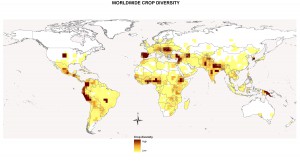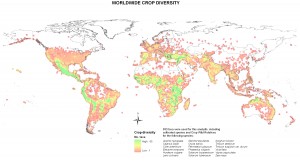On reading about the Atlas of Global Conservation here a few days ago, Nora Castaneda of Bioversity International’s Regional Office for the Americas sent me some of her own forays in that area, which are focused on plant species of agricultural interest. They’re still works in progress, and unpublished, 1 but definitely worth having a quick look at. The data comes from germplasm databases (SINGER, GRIN, EURISCO) and the databases put together for the GapAnalysis project, about which we have already blogged about here.
Here’s what the distribution of numbers of accessions of varieties of the major food crops in genebanks looks like. Dark brown means lots of different accessions (not varieties, mind!).

One has to wonder what’s going on in Spain. As I say, it’s a work in progress. A certain amount of data cleaning may still be necessary, for example to identify duplicates and take them out of the equation. And when Genebank Database Hell allows it should even be possible to take into account morphological and genetic diversity.
Anyway, here’s the distribution of richness of wild relative and landrace accessions of a number of major crops. Green means lots of species and landraces.

When finished, I think these maps will make a great complement to the Nature Conservancy’s Atlas. But would the biodiversity community be interested?
Most interesting, in fact. Here in Spain we’re eager to know the details of the data sources and analyses.